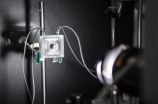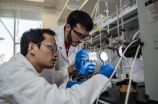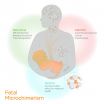(Press-News.org) Generating and storing renewable energy, such as solar or wind power, is a key barrier to a clean-energy economy. When the Joint Center for Artificial Photosynthesis (JCAP) was established at Caltech and its partnering institutions in 2010, the U.S. Department of Energy (DOE) Energy Innovation Hub had one main goal: a cost-effective method of producing fuels using only sunlight, water, and carbon dioxide, mimicking the natural process of photosynthesis in plants and storing energy in the form of chemical fuels for use on demand. Over the past five years, researchers at JCAP have made major advances toward this goal, and they now report the development of the first complete, efficient, safe, integrated solar-driven system for splitting water to create hydrogen fuels.
"This result was a stretch project milestone for the entire five years of JCAP as a whole, and not only have we achieved this goal, we also achieved it on time and on budget," says Caltech's Nate Lewis, George L. Argyros Professor and professor of chemistry, and the JCAP scientific director.
The new solar fuel generation system, or artificial leaf, is described in the August 24 online issue of the journal Energy and Environmental Science. The work was done by researchers in the laboratories of Lewis and Harry Atwater, director of JCAP and Howard Hughes Professor of Applied Physics and Materials Science.
"This accomplishment drew on the knowledge, insights and capabilities of JCAP, which illustrates what can be achieved in a Hub-scale effort by an integrated team," Atwater says. "The device reported here grew out of a multi-year, large-scale effort to define the design and materials components needed for an integrated solar fuels generator."
The new system consists of three main components: two electrodes--one photoanode and one photocathode--and a membrane. The photoanode uses sunlight to oxidize water molecules, generating protons and electrons as well as oxygen gas. The photocathode recombines the protons and electrons to form hydrogen gas. A key part of the JCAP design is the plastic membrane, which keeps the oxygen and hydrogen gases separate. If the two gases are allowed to mix and are accidentally ignited, an explosion can occur; the membrane lets the hydrogen fuel be separately collected under pressure and safely pushed into a pipeline.
Semiconductors such as silicon or gallium arsenide absorb light efficiently and are therefore used in solar panels. However, these materials also oxidize (or rust) on the surface when exposed to water, so cannot be used to directly generate fuel. A major advance that allowed the integrated system to be developed was previous work in Lewis's laboratory, which showed that adding a nanometers-thick layer of titanium dioxide (TiO2)--a material found in white paint and many toothpastes and sunscreens--onto the electrodes could prevent them from corroding while still allowing light and electrons to pass through. The new complete solar fuel generation system developed by Lewis and colleagues uses such a 62.5-nanometer-thick TiO2 layer to effectively prevent corrosion and improve the stability of a gallium arsenide-based photoelectrode.
Another key advance is the use of active, inexpensive catalysts for fuel production. The photoanode requires a catalyst to drive the essential water-splitting reaction. Rare and expensive metals such as platinum can serve as effective catalysts, but in its work the team discovered that it could create a much cheaper, active catalyst by adding a 2-nanometer-thick layer of nickel to the surface of the TiO2. This catalyst is among the most active known catalysts for splitting water molecules into oxygen, protons, and electrons and is a key to the high efficiency displayed by the device.
The photoanode was grown onto a photocathode, which also contains a highly active, inexpensive, nickel-molybdenum catalyst, to create a fully integrated single material that serves as a complete solar-driven water-splitting system.
A critical component that contributes to the efficiency and safety of the new system is the special plastic membrane that separates the gases and prevents the possibility of an explosion, while still allowing the ions to flow seamlessly to complete the electrical circuit in the cell. All of the components are stable under the same conditions and work together to produce a high-performance, fully integrated system. The demonstration system is approximately one square centimeter in area, converts 10 percent of the energy in sunlight into stored energy in the chemical fuel, and can operate for more than 40 hours continuously.
"This new system shatters all of the combined safety, performance, and stability records for artificial leaf technology by factors of 5 to 10 or more ," Lewis says.
"Our work shows that it is indeed possible to produce fuels from sunlight safely and efficiently in an integrated system with inexpensive components," Lewis adds, "Of course, we still have work to do to extend the lifetime of the system and to develop methods for cost-effectively manufacturing full systems, both of which are in progress."
Because the work assembled various components that were developed by multiple teams within JCAP, coauthor Chengxiang Xiang, who is co-leader of the JCAP prototyping and scale-up project, says that the successful end result was a collaborative effort. "JCAP's research and development in device design, simulation, and materials discovery and integration all funneled into the demonstration of this new device," Xiang says.
INFORMATION:
These results are published in a paper titled "A monolithically integrated, intrinsically safe, 10% efficient, solar-driven water-splitting system based on active, stable earth-abundant electrocatalysts in conjunction with tandem III-V light absorbers protected by amorphous TiO2 films." In addition to Lewis, Atwater, and Xiang, other Caltech coauthors include graduate student Erik Verlage, postdoctoral scholars Shu Hu and Ke Sun, material processing and integration research engineer Rui Liu, and JCAP mechanical engineer Ryan Jones. Funding was provided by the Office of Science at the U.S. Department of Energy, and the Gordon and Betty Moore Foundation.
If you think that performing CPR on a person whose heart has stopped is a surefire way to save their life, you may be watching too much TV.
The truth is more depressing than fiction, according to a new study by University of Southern California Davis School of Gerontology researchers. While medical dramas Grey's Anatomy and House show cardiopulmonary resuscitation saving a patient's life nearly 70 percent of the time, the real immediate survival rate is nearly half that - around 37 percent.
Researchers also found another discrepancy between reality and TV: Half of ...
TAMPA, Fla. - Pancreatic cancer is the fourth most common cause of cancer-related death in the United States and has a 5-year survival rate of only 6 percent, which is the lowest rate of all types of cancer according to the American Cancer Society. This low survival rate is partially attributed to the difficulty in detecting pancreatic cancer at an early stage. According to a new 'proof of principle' study published in Aug. 27 issue of Cancer Prevention Research, Moffitt Cancer Center researchers hope to improve pancreatic cancer survival rates by identifying markers in ...
Beach sand contains all kinds of microorganisms, including those that can harm human health. Yet current guidelines are focused exclusively on monitoring the levels of microbes in the water.
Now, an international panel of scientists is recommending monitoring the sand at recreational beaches, to minimize health risks for beachgoers. Their advice is based on the general consensus reached during the international conference "Trends in Environmental Microbiology and Public Health," held in Lisbon Portugal in September 2014.
"Beach sands accumulate contaminants and people ...
A collaboration between biologists and engineers at Monash University has led to the development of a new non-invasive image processing technique to visualise embryo formation. Researchers were able to see, for the first time, the movement of all of the cells in living mammalian embryos as they develop under the microscope. This breakthrough has important implications for IVF (in vitro fertilisation) treatments and pre-implantation genetic diagnosis (PGD). In the future, this approach could help with embryo selection before the embryo is implanted back into the uterus to ...
A German-French team has developed a light-sensitive switch that regulates a protein implicated in the neurobiology of synaptic plasticity. The agent promises to shed new light on the phenomenology of learning, memory and neurodegeneration.
Learning is made possible by the fact that the functional connections between nerve cells in the brain are subject to constant remodeling. As a result of activation-dependent modification of these links ('synaptic plasticity'), circuits that are repeatedly stimulated "learn" to transmit signals ever more efficiently. This process is ...
This news release is available in German.
A new international study shows that 5,000 foetuses in Europe annually are affected by spina bifida and other severe defects on the central nervous system. Seventy per cent of these pregnancies are terminated, while increased mortality and serious diseases affect the children who are born. At least half of the cases can be avoided by adding folic acid to staple foods as is already being done in seventy non-European countries.
A lack of folic acid enrichment in Europe is the cause of several thousand cases of foaetal abnormalities ...
Parents go to great lengths to ensure the health and well-being of their developing offspring. The favor, however, may not always be returned.
Dramatic research has shown that during pregnancy, cells of the fetus often migrate through the placenta, taking up residence in many areas of the mother's body, where their influence may benefit or undermine maternal health.
The presence of fetal cells in maternal tissue is known as fetal microchimerism. The term alludes to the chimeras of ancient Greek myth--composite creatures built from different animal parts, like the goat-lion-serpent ...
When a plant dies, its leaves and branches fall to the ground. Decomposition of soil organic matter is then mainly carried out by fungi and bacteria, which convert dead plant materials into carbon dioxide and mineral nutrients.
Until now, scientists have thought that high quality organic materials, such as leaves that are rich in soluble sugars, are mainly decomposed by bacteria. Lower quality materials, such as cellulose and lignin that are found in wood, are mainly broken down by fungi.
Previous research has also shown that organic material that is broken down by ...
The scientific team of a new biotech company Gero in collaboration with one of the leading academics in the field of aging Prof. Robert J. Shmookler Reis (current world record holder in life extension for model animals - 10 fold for nematodes) has recently brought new insights into biology of aging and age-related diseases, primarily, around the stability and stress resistance of certain gene regulatory networks. The work has just been published as "Stability analysis of a model gene network links aging, stress resistance, and negligible senescence" in Scientific Reports ...
A new method of manufacturing glass could lead to the production of 'designer glasses' with applications in advanced photonics, whilst also facilitating industrial scale carbon capture and storage. An international team of researchers, writing today in the journal Nature Communications, report how they have managed to use a relatively new family of sponge-like porous materials to develop new hybrid glasses.
The work revolves around a family of compounds called metal-organic frameworks (MOFs), which are cage-like structures consisting of metal ions, linked by organic bonds. ...



